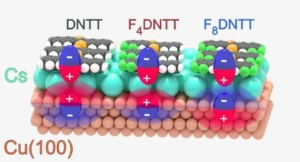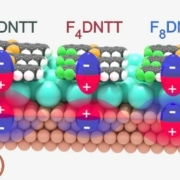On the Role of Collective Electrostatic Effects in Electronic Level Pinning and Work Function Changes by Molecular Adlayers: The Case of Partially Fluorinated DNTTs Adsorbed Flat-Lying on Various Metals and Hetero-Structures – Publication by A2 (Witte) and A8 (Koert)
In a new publication in Advanced Materials Interfaces, the groups of Gregor Witte (A2), Ulrich Koert (A8) as well as Jérôme Cornil from the University of Mons report on the formation of an internal interface dipole at a metal/2D metal/organic hetero-interface, which can be modified by the outer organic monolayer.

Schematic representation of the outer and internal interface dipoles at the FxDNTT/cesium/copper hetero-interface (Image: Maximilian Dreher, CC BY-NC-ND 4.0).
The use of organic contact layers is a versatile tool to control the work function of metal electrodes. While partial fluorination of robust organic molecules leads to a significant shift of their frontier energy levels in the isolated molecules, this effect can be wiped out for organic films adsorbed on high work function metal substrates leading to an equalization of the corresponding HOMO levels. Consequently, also the work function shift is equalized in the condensed phase, which is often referred to as HOMO (resp. LUMO) level pinning. Especially the LUMO level pinning has been reported only on a theoretical level in literature yet.
By using partially fluorinated DNTTs, which were synthesized by project A8 and exhibit such a HOMO level pinning on high work function noble metals, the group of Jérôme Cornil (Mons, Belgium) demonstrated that a LUMO level pinning also exists on low work function Cs(110) surfaces on a theoretical level. To face low work function surfaces experimentally, Maximilian Dreher and coworkers used atomically thin cesium layers that grow epitaxial on Cu(100) single crystals and provide more inert, low work function surfaces. In contrast to the expectation, this copper/cesium/organic hetero-stack reveals no LUMO pinning effect. Complementary DFT calculations demonstrate, that the contributions prevailing on the work function shift can be separated into (i) an outer interface dipole between the organic layer and the 2D cesium layer and (ii) an inner, buried interface dipole at the metal/cesium interface. While the outer interface dipole is again equalized for the different FxDNTT species, the buried interface dipole is modulated dependent on the degree of fluorination of the molecules.
Such a sandwich hetero-interface provides new possibilities to effectively tailor contact layers between metal electrodes and active organic layers improving their energy level alignment and emphasizes the importance of internal interfaces.
Publication
M. Dreher, D. Cornil, M. W. Tripp, U. Koert, J. Cornil, G. Witte
On the Role of Collective Electrostatic Effects in Electronic Level Pinning and Work Function Changes by Molecular Adlayers: The Case of Partially Fluorinated DNTTs Adsorbed Flat-Lying on Various Metals and Hetero-Structures
Adv. Mater. Interfaces (2022) DOI:10.1002/admi.202200361
Contact
Prof. Dr. Gregor Witte
Philipps-Universität Marburg
SFB 1083 project A2
Tel.: 06421 28-21384
EMAIL







